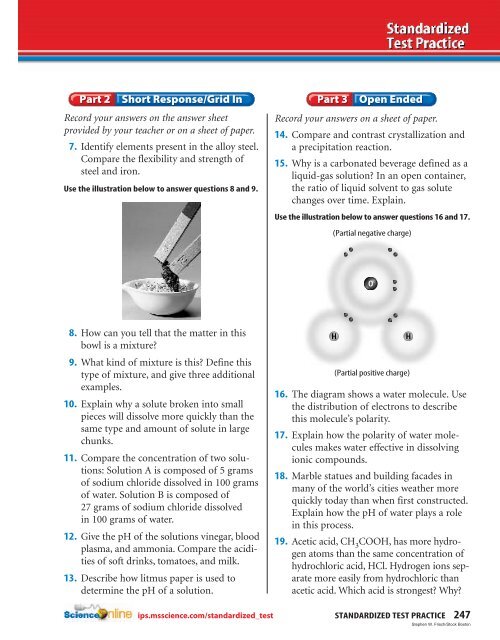Substances, Mixtures, and Solubility - McGraw-Hill Higher Education
Substances, Mixtures, and Solubility - McGraw-Hill Higher Education
Substances, Mixtures, and Solubility - McGraw-Hill Higher Education
You also want an ePaper? Increase the reach of your titles
YUMPU automatically turns print PDFs into web optimized ePapers that Google loves.
Record your answers on the answer sheet<br />
provided by your teacher or on a sheet of paper.<br />
7. Identify elements present in the alloy steel.<br />
Compare the flexibility <strong>and</strong> strength of<br />
steel <strong>and</strong> iron.<br />
Use the illustration below to answer questions 8 <strong>and</strong> 9.<br />
Record your answers on a sheet of paper.<br />
14. Compare <strong>and</strong> contrast crystallization <strong>and</strong><br />
a precipitation reaction.<br />
15. Why is a carbonated beverage defined as a<br />
liquid-gas solution In an open container,<br />
the ratio of liquid solvent to gas solute<br />
changes over time. Explain.<br />
Use the illustration below to answer questions 16 <strong>and</strong> 17.<br />
(Partial negative charge)<br />
O<br />
8. How can you tell that the matter in this<br />
bowl is a mixture<br />
H<br />
H<br />
9. What kind of mixture is this Define this<br />
type of mixture, <strong>and</strong> give three additional<br />
examples.<br />
10. Explain why a solute broken into small<br />
pieces will dissolve more quickly than the<br />
same type <strong>and</strong> amount of solute in large<br />
chunks.<br />
11. Compare the concentration of two solutions:<br />
Solution A is composed of 5 grams<br />
of sodium chloride dissolved in 100 grams<br />
of water. Solution B is composed of<br />
27 grams of sodium chloride dissolved<br />
in 100 grams of water.<br />
12. Give the pH of the solutions vinegar, blood<br />
plasma, <strong>and</strong> ammonia. Compare the acidities<br />
of soft drinks, tomatoes, <strong>and</strong> milk.<br />
13. Describe how litmus paper is used to<br />
determine the pH of a solution.<br />
ips.msscience.com/st<strong>and</strong>ardized_test<br />
(Partial positive charge)<br />
16. The diagram shows a water molecule. Use<br />
the distribution of electrons to describe<br />
this molecule’s polarity.<br />
17. Explain how the polarity of water molecules<br />
makes water effective in dissolving<br />
ionic compounds.<br />
18. Marble statues <strong>and</strong> building facades in<br />
many of the world’s cities weather more<br />
quickly today than when first constructed.<br />
Explain how the pH of water plays a role<br />
in this process.<br />
19. Acetic acid, CH 3<br />
COOH, has more hydrogen<br />
atoms than the same concentration of<br />
hydrochloric acid, HCl. Hydrogen ions separate<br />
more easily from hydrochloric than<br />
acetic acid. Which acid is strongest Why<br />
STANDARDIZED TEST PRACTICE 247<br />
Stephen W. Frisch/Stock Boston

















